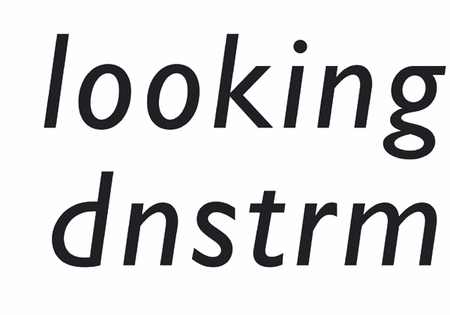From Specimens, 8pp pamphlet,
Axminster 1998. [ View detail ]
...................................................
Marriages or engagements between Bewick and Wadsworth for example, and abbreviation as a form: whether in the rendered line on a map, the hatched wooden block, or a diminution of the spelt word (via ‘de-vowelling’, or coppicing).
“The vignette, by its general appearance, presents itself both as a global metaphor for the world and as a fragment. Dense at its center, tenuous on the periphery, it seems to disappear into the page: this makes it a naive but powerful metaphor of the infinite, a symbol of the universe; at the same time, the vignette is fragmentary, sometimes even minute in scale, incomplete, mostly dependent upon the text for its meaning, with irregular and ill-defined edges, ... It is the perfect Romantic formula.”
Charles Rosen & Henri Zerner: Romanticism and Realism, the mythology of nineteenth century art, London 1984.
“As soon as the days began to lengthen, and the sprouting herbage had covered the ground, I often stopped with delight by the sides of woods, to admire the dangling woodbine and roses, and the grasses powdered or spangled with pearly drops of dew; and also, week after week, the continued succession of plants and wild flowers. The primrose, the hyacinth, the harebell, the daisy, the cowslip, etc,—these, altogether, I thought no painter could ever imitate... While admiring these beautifully-enamelled spots on my way, I was also charmed with the equally beautiful little songsters, which were constantly pouring out their various notes to proclaim the spring.”
A Memoir of Thomas Bewick, Newcastle-on-Tyne 1862.
“The divergence of our present-day woods from the type of the primitive natural forest is largely due to ‘coppicing’, a practice dating from mediaeval times. In coppiced woods the small timber (shrubs and small trees) is cut down at intervals of 10 to 15 years and allowed to grow again from the stools. Hazel, chestnut, hornbeam, ash and birch provide the most useful coppice timber, but many others of the native trees and shrubs are treated in the same way. ... The traditional practice of coppicing does not involve the complete clearing of a wood; a number of trees, chiefly the oaks are left to grow, and are extracted for heavy timber as they mature.”
S.W. Wooldridge & Geoffrey E. Hutchings: London’s Country- side, geographical field work for students and teachers of geography, London 1957.
“The drawing is indicated rather hesitatingly in outline. Shadows are then suggested by a very deliberate even hatching. One has then a complete little picture in light and shade only. The shadows are heightened and colour indicated by cross hatching. Also outlines are corrected and accentuated and details added. In fact, at this stage, one treats the drawing as if it were a little painting, adding tone here or an accent there, until it is brought up to the necessary pitch.”
Edward Ardizzone, ‘Line drawing’ in A Handbook of Type and Illustration, ed. John Lewis; London 1956.
“The heap of angular girders rising up from a clump of connecting rods at the bottom of the design seem as convincing as the industrial mechanisms which must have inspired their creation. When each separate shape is scrutinized in detail, the print is seen to be the sum of a number of surprisingly different parts: squares tilted sideways so that they are metamorphosed into mysterious diamonds hammered out of iron, rows of straight bars which take on the force of a prison cage when set into the middle of their geometrical containers.”
The description of Edward Wadsworth‘s ‘Untitled: Abstract Woodcut’ c.1914–15 in Vorticism and its allies, Richard Cork; London 1974.
“... while Vorticism lasted it was a vitalizing influence, perhaps the most lively effort ever made to infuse our timid English aestheticism with Latin intellectualism. It failed because there was some disparity of sense and sensibility. Like the Italian Futurists, the English Vorticists tried to take the mind by assault, forgetting that art wins its positions by subtle infiltration.”
Herbert Read: Contemporary British Art, Harmondsworth, Middx. 1951.
“I should explain that Wreyland is land by the Wrey, a little stream in Devonshire. The Wrey flows into the Bovey, and the Bovey into the Teign, and the Teign flows into the sea at Teignmouth. The land is on the east side of the Wrey, just opposite the village of Lustleigh. It forms a manor, and gives its name to a hamlet of six houses, of which this is one.”
This perfectly balanced little description of location is from the preface to Small Talk at Wreyland, Cecil Torr; Cambridge 1918.
“A map represents the features of a piece of country all to the same scale, correct in their lateral disposition and orientation. When the same features are viewed from a point on the ground, even from a high vantage point, they are seen in an exacting perspective. Their apparent size is influenced by their distance from the observer; some features are partly or wholly hidden by others; some are strangely foreshortened; some appear to be falsely oriented. Again, a feature may appear more prominent or more obscure than the observer would expect from its representation on the map. Only practice can enable the observer to reconcile the imaginary vertical view given by the map with the near-horizontal view of the country to which he, placed on the earth’s surface, is inevitably committed.”
Geoffrey Hutchings: An Introduction to Geographical Landscape Drawing, Dorking, Surrey 1955.
“The 1:1250 maps are at the largest of all current Ordnance Survey scales, and, as such, particular interest attaches to the amount of detail they contain, the method of its representation, and its relationship to features actually on the ground. ... Overhead features, distinguished by pecked lines, are shown when they are of a size and character to be useful features, but where less than 1m wide they have to be of particular importance to warrant inclusion. Underground detail, likewise depicted by pecked lines, is only included where it is a continuation (in tunnels and subways) of communications which normally run on the surface.”
J.B. Harley: Ordnance Survey Maps, a descriptive manual, Southampton 1975.
“In Tansley’s analysis of ‘The nature and status of British Woodlands’—Chapter XII in
The British Islands and their Vegetation, the following trees are listed as dominant in British woodlands: Pedunculate oak, Sessile oak, Beech, Birch, Ash, Pine, Alder; and as ‘other trees’ Tansley cites: Yew, Hornbeam, Holly, Sycamore, Maple, Wych elm, Willows (Salix species), Rowan, Whitebeam, Crab apple, Cherry or Gean, Bird Cherry, Small-leaved lime, Large-leaved lime, Poplars; and among the ‘more important shrubs’ according to Tansley, are: Hazel, Hawthorn, Juniper, Willows (other species of Salix).”
Winifred Pennington: The History of British Vegetation, 2nd edition, London 1974.








*
[abr, 0:06] [bxwd blck, 0:06] [cppc, 0:06] [hllw plld wllw, 0:09]
[upstrm dnstrm, 0:06] [myeyes, 0:06] [sameas, 0:06] [wdlnd vgntt, 0:06]
First online publication and exhibition, December 2009
